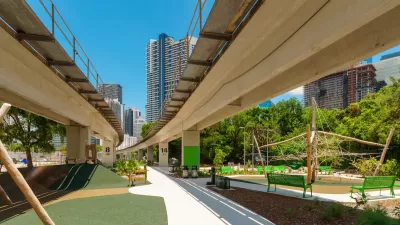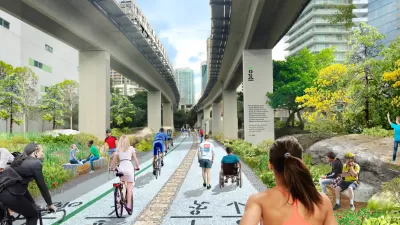The Underline will run for ten miles under Metrorail's elevated tracks in Miami.

The Miami Herald is chronicling the beginning of construction on the Miami Underline, touting the project's catalytic potential on the model of New York City's High Line.
An article by Andres Viglucci describes the Underline as "a 10-mile-long park and walking and cycling trail that aims to regenerate an overlooked swath of Miami in the same way the heralded High Line did along lower Manhattan."
Viglucci explains more detail about the groundbreaking and initial work on the Underline:
On Thursday, a contractor is scheduled to break ground on the first phase of the much-anticipated Underline, which will eventually extend from downtown Miami to Dadeland under the Metrorail’s elevated tracks. That initial segment, in the booming Brickell district, is just seven blocks and a half-mile long.
But moving from conception to construction in five years is a flash for a civic project in Miami. At least two more segments, one along Miami’s The Roads section and another in Coral Gables, will follow in short order.
A lot of the article's focus is devoted to the advocacy work of Meg Daly and her father, the late Parker Thomson, in paving the way for the project. The article also notes that High Line designer James Corner Field Operations also completed the master plan for the Underline, revealed in 2015.
A previous article by Douglas Hanks reported on the $14 million construction contract that cleared the way for construction to begin.
Building the entire 10-mile Underline park is expected to cost about $120 million, with another $3 million required to maintain it each year. The “Brickell Backyard” segment that was funded [in October] represents just 5 percent of the full Underline, but founder Meg Daly said she sees the launch of actual construction along the route as a larger milestone than the seven-block footprint between the river and Southwest Thirteenth Street suggests.
FULL STORY: Miami’s answer to the High Line breaks ground this week. This could change the city.

Planetizen Federal Action Tracker
A weekly monitor of how Trump’s orders and actions are impacting planners and planning in America.

Maui's Vacation Rental Debate Turns Ugly
Verbal attacks, misinformation campaigns and fistfights plague a high-stakes debate to convert thousands of vacation rentals into long-term housing.

San Francisco Suspends Traffic Calming Amidst Record Deaths
Citing “a challenging fiscal landscape,” the city will cease the program on the heels of 42 traffic deaths, including 24 pedestrians.

Amtrak Rolls Out New Orleans to Alabama “Mardi Gras” Train
The new service will operate morning and evening departures between Mobile and New Orleans.

The Subversive Car-Free Guide to Trump's Great American Road Trip
Car-free ways to access Chicagoland’s best tourist attractions.

San Antonio and Austin are Fusing Into one Massive Megaregion
The region spanning the two central Texas cities is growing fast, posing challenges for local infrastructure and water supplies.
Urban Design for Planners 1: Software Tools
This six-course series explores essential urban design concepts using open source software and equips planners with the tools they need to participate fully in the urban design process.
Planning for Universal Design
Learn the tools for implementing Universal Design in planning regulations.
Heyer Gruel & Associates PA
JM Goldson LLC
Custer County Colorado
City of Camden Redevelopment Agency
City of Astoria
Transportation Research & Education Center (TREC) at Portland State University
Jefferson Parish Government
Camden Redevelopment Agency
City of Claremont




























